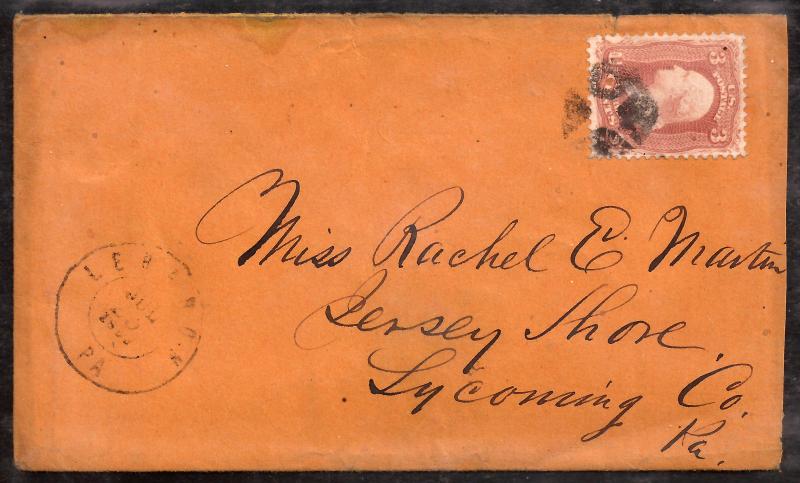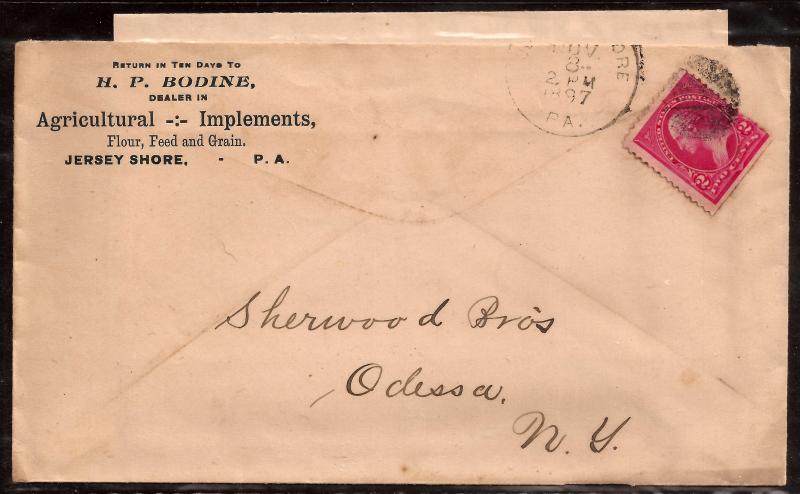Post by I.L.S. on Jan 27, 2015 23:20:04 GMT
OK, I have an old Jersey Shore, Pa. stampless letter addresses to a Hugh Bellas ,and just yesterday I acquired yet another but this one is sort of written in an almost a gibberish fashion that I cant quite understand? But what is very interesting is that they are both very close together in date (10 days apart actually) and the same year. It seems he must have either been consulting a surveyor or was one that I'm not really clear on. Maybe one of you genealogy specialists can point me in the right direction. Have a look please won't you? Thank you very humbly for any attention, advice or information in advance. -Jeff
New acquisition (not in-hand/sellers image)

My original one (same recipient)
Front:

Back:

Content part 1.

Content part 2.

The original post where I attempted researching it out a little bit but unsure of the details as I wasn't (& still not) that great at it quite yet but it's mentioned & shown here -
thestampforum.boards.net/thread/53/stampless-covers-folded-letters
I don't know if it's worth mentioning or not but this small River/lumber town of Jersey Shore, Pa. was "briefly" left with out a newspaper from 1835 until January of 1846. as cited from a reference on the town. It could be a dead end or a reason to write more for news and in this case land surveying?Just a thought was all.
(I'll provide the link underneath)
The above & aforementioned link:
www.usgennet.org/usa/pa/county/lycoming/history/Chapter-28.html
New acquisition (not in-hand/sellers image)

My original one (same recipient)
Front:

Back:

Content part 1.

Content part 2.

The original post where I attempted researching it out a little bit but unsure of the details as I wasn't (& still not) that great at it quite yet but it's mentioned & shown here -
thestampforum.boards.net/thread/53/stampless-covers-folded-letters
I don't know if it's worth mentioning or not but this small River/lumber town of Jersey Shore, Pa. was "briefly" left with out a newspaper from 1835 until January of 1846. as cited from a reference on the town. It could be a dead end or a reason to write more for news and in this case land surveying?Just a thought was all.
(I'll provide the link underneath)
"Jersey Shore has had a number of newspapers. The first, name the West Branch Courier, by Daniel Gotshall, came into existence January 8, 1827, and ceased about 1830.
In 1828 a humorous little sheet called The Nose appeared. It was published by William Piatt, Jr., and lived but a short time.
Alexander Hamilton started The Anti-Masonic Advocate about 1830, and published it until the winter of 1834. It then passed into the hands of Loehr & Middleton, who discontinued it in 1835.
After the suspension of the Advocate Jersey Shore was without a paper until January, 1846. At this date The Republican was started by S. S. Seely, and he issued it until October, 1850, when the office, with much surrounding property, was destroyed by fire. The borough was again without a paper till June, 1851, when The Republican in an enlarged form was resuscitated by its old publisher. In September, 1851, Robert Baker became associated with Seely and the paper was continued by them until June 9, 1852. At this time Seely sold his interest to J. Sallade, and it was published by the firm of Baker & Sallade until Time 9, 1854, with John F. Meginness as editor, when Sallade and Meginness retired, the former having sold his share to Baker. After this change the paper was continued for a few years by the firm of R. & F. A. Baker.
On the 29th of June, 1854, the first number of The News Letter was issued by Seely & Meginness, and they conducted it until August 30,1855, when Meginness retired and Seely became sole owner and publisher. December 6, 1855, James Jones became associated with Seely, but he retired from the partnership on the 18th of September, 1856. Seely continued alone for some time, when he discontinued its publication.
The National Vidette was started, May 15, 1855, by H. J. B. & L. J. Cummings, and continued by them for six months, when the senior member of the firm retired. The junior issued a few numbers, when he retired also and the paper ceased to exist.
After lying idle until the 25th of September, 1856, it was resuscitated by James Jones and published by him until May 24, 1871, when the office, with all its contents excepting two presses, was destroyed by fire. After this calamity the paper remained dormant until May, 1887, when it was revived by J. W. and R. H. Grier, and they have continued it to the present time as a Republican paper.
After suspending The News Letter Col. S. S. Seely remained idle for a short time. In 1860 Moore & Snyder started the Jersey Shore Herald and ran it until 1862. Bruce Coleman bought Moore's interest, and the new firm continued about a year, when Colonel Seely bought out Coleman. In a short time be purchased Snyder's share and became sole owner. Seely conducted the paper until September 1, 1879, when it was purchased by his son, Charles B. Seely, by whom it has been published up to the present time. In politics it is Democratic. Colonel Seely died, September 5, 1879. He was a veteran publisher and editor, and was noted for his excellence and taste as a workman."
In 1828 a humorous little sheet called The Nose appeared. It was published by William Piatt, Jr., and lived but a short time.
Alexander Hamilton started The Anti-Masonic Advocate about 1830, and published it until the winter of 1834. It then passed into the hands of Loehr & Middleton, who discontinued it in 1835.
After the suspension of the Advocate Jersey Shore was without a paper until January, 1846. At this date The Republican was started by S. S. Seely, and he issued it until October, 1850, when the office, with much surrounding property, was destroyed by fire. The borough was again without a paper till June, 1851, when The Republican in an enlarged form was resuscitated by its old publisher. In September, 1851, Robert Baker became associated with Seely and the paper was continued by them until June 9, 1852. At this time Seely sold his interest to J. Sallade, and it was published by the firm of Baker & Sallade until Time 9, 1854, with John F. Meginness as editor, when Sallade and Meginness retired, the former having sold his share to Baker. After this change the paper was continued for a few years by the firm of R. & F. A. Baker.
On the 29th of June, 1854, the first number of The News Letter was issued by Seely & Meginness, and they conducted it until August 30,1855, when Meginness retired and Seely became sole owner and publisher. December 6, 1855, James Jones became associated with Seely, but he retired from the partnership on the 18th of September, 1856. Seely continued alone for some time, when he discontinued its publication.
The National Vidette was started, May 15, 1855, by H. J. B. & L. J. Cummings, and continued by them for six months, when the senior member of the firm retired. The junior issued a few numbers, when he retired also and the paper ceased to exist.
After lying idle until the 25th of September, 1856, it was resuscitated by James Jones and published by him until May 24, 1871, when the office, with all its contents excepting two presses, was destroyed by fire. After this calamity the paper remained dormant until May, 1887, when it was revived by J. W. and R. H. Grier, and they have continued it to the present time as a Republican paper.
After suspending The News Letter Col. S. S. Seely remained idle for a short time. In 1860 Moore & Snyder started the Jersey Shore Herald and ran it until 1862. Bruce Coleman bought Moore's interest, and the new firm continued about a year, when Colonel Seely bought out Coleman. In a short time be purchased Snyder's share and became sole owner. Seely conducted the paper until September 1, 1879, when it was purchased by his son, Charles B. Seely, by whom it has been published up to the present time. In politics it is Democratic. Colonel Seely died, September 5, 1879. He was a veteran publisher and editor, and was noted for his excellence and taste as a workman."
The above & aforementioned link:
www.usgennet.org/usa/pa/county/lycoming/history/Chapter-28.html



















